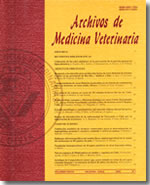Detection of viremia in the Porcine rubulavirus experimental infection
Main Article Content
Abstract
The Porcine rubulavirus (PoRV) is the causal agent of Blue Eye Disease, an endemic disease in Mexico known since 1980, which is characterised by a progressive fatal meningo-encephalitis in piglets and reproductive failure in adults pigs, accompanied with respiratory symptoms and corneal opacity. PoRV mainly replicates in the respiratory and central nervous system, however, it is also detected in other organs such as testis, epididymis, prostate, ovaries, spleen, liver, thymus and lymphatic nodes. These findings suggest the existence of a viremic phase that leads to a systemic virus spread. In this paper we study the viremia in experimentally PoRV-infected post-pubertal pigs. Virus antigen was detected on the surface of erythrocytes from 4 to 12 days post-infection (p.i.) and was identified inside of leukocytes from 12 days until the end of experiment (20 days p.i.); which suggest that these cells are used as virus spread elements. The PoRV-specific antibodies were detected since the first week p.i., but the highest titers were reached at 16 days pi, which coincided with the disappearance of free virus in the blood. No abnormalities were presented in hematological parameters of infected pigs.

